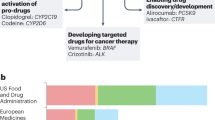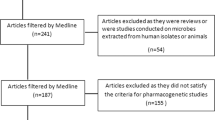Abstract
Pharmacogenetic association studies have the potential to identify variations in DNA sequence which impact drug response. Identifying these DNA variants can help to explain interindividual variability in drug response; this is the first step in personalizing dosing and treatment regimes to a patient's needs. There are many intricacies in the design and analysis of pharmacogenetic association studies, including having adequate power, selecting proper endpoints, detecting and correcting the effects of population stratification, modeling genetic and nongenetic covariates accurately, and validating the results. At this point there are no formal guidelines on the design and analysis of pharmacogenetic studies. The Industry Pharmacogenomics Working Group has initiated discussions regarding potential guidelines for pharmacogenetic study design and analyses (http://i-pwg.org) and the results from these discussions are presented in this paper.
This is a preview of subscription content, access via your institution
Access options
Subscribe to this journal
Receive 6 print issues and online access
$259.00 per year
only $43.17 per issue
Buy this article
- Purchase on Springer Link
- Instant access to full article PDF
Prices may be subject to local taxes which are calculated during checkout


Similar content being viewed by others
References
Consortium TIH . The International HapMap Project. Nature 2003; 426: 789–796.
International HapMap Consortium. A haplotype map of the human genome. Nature 2005; 437: 1299–1320.
Lanfear DE, McLeod HL . Pharmacogenetics: using DNA to optimize drug therapy. Am Fam Physician 2007; 76: 1179–1182.
US Food and Drug Administration. E15 Definitions for Genomic Biomarkers, Pharmacogenomics, Pharmacogenetics, Genomic Data and Sample Coding Categories: Guidance for Industry, Apr 2008. Fed Regist 2008; 73: 19074 http://www.fda.gov/cber/gdlns/iche15term.htm Accessibility verified 23 May 2008.
Rauch A, Nolan D, Martin A, McKinnon E, Almeida C, Mallal S . Prospective genetic screening decreases the incidence of abacavir hypersensitivity reactions in the Western Australian HIV cohort study. Clin Infect Dis 2006; 43: 99–102.
McPherson R, Pertsemlidis A, Kavaslar N, Stewart A, Roberts R, Cox DR et al. A common allele on chromosome 9 associated with coronary heart disease. Science 2007; 316: 1488–1491.
Zuo Y, Zou G, Wang J, Zhao H, Liang H . Optimal two-stage design for case–control association analysis incorporating genotyping errors. Ann Hum Genet 2008; 72: 375–387.
Yang HH, Hu N, Taylor PR, Lee MP . Whole genome-wide association study using Affymetrix SNP chip: a two-stage sequential selection method to identify genes that increase the risk of developing complex diseases. Methods Mol Med 2008; 141: 23–35.
Wang X, Zhang Z, Zhang S, Sha Q . Genome-wide association tests by two-stage approaches with unified analysis of families and unrelated individuals. BMC Proc 2007; 1 (Suppl 1): S140.
Skol AD, Scott LJ, Abecasis GR, Boehnke M . Optimal designs for two-stage genome-wide association studies. Genet Epidemiol 2007; 31: 776–788.
Hirschhorn JN, Daly MJ . Genome-wide association studies for common diseases and complex traits. Nat Rev Genet 2005; 6: 95–108.
Skol AD, Scott LJ, Abecasis GR, Boehnke M . Joint analysis is more efficient than replication-based analysis for two-stage genome-wide association studies. Nat Genet 2006; 38: 209–213.
Yang Q, Cui J, Chazaro I, Cupples LA, Demissie S . Power and type I error rate of false discovery rate approaches in genome-wide association studies. BMC Genet 2005; 6 (Suppl 1): S134.
Frazer KA, Ballinger DG, Cox DR, Hinds DA, Stuve LL, Gibbs RA et al. A second generation human haplotype map of over 3.1 million SNPs. Nature 2007; 449: 851–861.
NCBI. Database of single nucleotide polymorphisms http://www.ncbi.nlm.nih.gov/SNP/2007; dbSNP Build ID: /{build 128/} Accessibility verified 23 May 2008.
McCarthy JJ, Hilfiker R . The use of single-nucleotide polymorphism maps in pharmacogenomics. Nat Biotechnol 2000; 18: 505–508.
De La Vega FM, Isaac H, Collins A, Scafe CR, Halldorsson BV, Su X et al. The linkage disequilibrium maps of three human chromosomes across four populations reflect their demographic history and a common underlying recombination pattern. Genome Res 2005; 15: 454–462.
Dunning AM, Durocher F, Healey CS, Teare MD, McBride SE, Carlomagno F et al. The extent of linkage disequilibrium in four populations with distinct demographic histories. Am J Hum Genet 2000; 67: 1544–1554.
Carlson CS, Eberle MA, Rieder MJ, Yi Q, Kruglyak L, Nickerson DA . Selecting a maximally informative set of single-nucleotide polymorphisms for association analyses using linkage disequilibrium. Am J Hum Genet 2004; 74: 106–120.
Sherry ST, Ward MH, Kholodov M, Baker J, Phan L, Smigielski EM et al. dbSNP: the NCBI database of genetic variation. Nucleic Acids Res 2001; 29: 308–311.
Wiviott SD, Antman EM, Gibson CM, Montalescot G, Riesmeyer J, Weerakkody G et al. Evaluation of prasugrel compared with clopidogrel in patients with acute coronary syndromes: design and rationale for the TRial to assess Improvement in Therapeutic Outcomes by optimizing platelet InhibitioN with prasugrel Thrombolysis In Myocardial Infarction 38 (TRITON-TIMI 38). Am Heart J 2006; 152: 627–635.
Najarian RM, Sullivan LM, Kannel WB, Wilson PW, D'Agostino RB, Wolf PA . Metabolic syndrome compared with type 2 diabetes mellitus as a risk factor for stroke: the Framingham Offspring Study. Arch Intern Med 2006; 166: 106–111.
Hippisley-Cox J, Coupland C, Vinogradova Y, Robson J, May M, Brindle P . Derivation and validation of QRISK, a new cardiovascular disease risk score for the United Kingdom: prospective open cohort study. BMJ 2007; 335: 136.
Risner ME, Saunders AM, Altman JF, Ormandy GC, Craft S, Foley IM et al. Efficacy of rosiglitazone in a genetically defined population with mild-to-moderate Alzheimer's disease. Pharmacogenomics J 2006; 6: 246–254.
Martin AM, Nolan D, Gaudieri S, Almeida CA, Nolan R, James I et al. Predisposition to abacavir hypersensitivity conferred by HLA-B*5701 and a haplotypic Hsp70-Hom variant. Proc Natl Acad Sci USA 2004; 101: 4180–4185.
Gauderman WJ, Morrison JM . QUANTO 1.1: a computer program for power and sample size calculations for genetic-epidemiology studies. 2006. http://hydra.usc.edu/gxe Accessibility verified 23 May 2008.
Pritchard JK, Przeworski M . Linkage disequilibrium in humans: models and data. Am J Hum Genet 2001; 69: 1–14.
Agresti A . Categorical Data Analysis. John Wiley & Sons, Inc.: New York, 1990.
Draper N, Smith H . Applied Regression Analysis. John Wiley & Sons, Inc.: New York, 1981.
Efron B, Tibshirani RJ . An Introduction to the Bootstrap. Chapman and Hall: New York, 1993.
Hosmer DW, Lemeshow S . Applied Logistic Regression. John Wiley & Sons, Inc.: New York, 2000.
Lachin JM . Biostatistical Methods, The Assessment of Relative Risks. John Wiley & Sons, Inc.: New York, 2000.
Lee ET . Statistical Methods for Survival Data Analysis. John Wiley & Sons, Inc.: New York, 1992.
Lehman EL . Nonparameterics, Statistical Methods Based on Ranks. Prentice Hall: Upper Saddle River, 1998.
Souverein OW, Zwinderman AH, Tanck MW . Multiple imputation of missing genotype data for unrelated individuals. Ann Hum Genet 2006; 70: 372–381.
Moore JH . Unit 1.14: Analysis of gene-gene interactions. Current Protocols in Human Genetics. John Wiley and Sons, Inc.: New York, 2007, pp 1.14.11–11.14.11.
Altshuler D, Kruglyak L, Lander E . Genetic polymorphisms and disease. N Engl J Med 1998; 338: 1626.
Lander ES, Schork NJ . Genetic dissection of complex traits. Science 1994; 265: 2037–2048.
Thomas DC, Witte JS . Point: population stratification: a problem for case–control studies of candidate-gene associations? Cancer Epidemiol Biomarkers Prev 2002; 11: 505–512.
Marchini J, Cardon LR, Phillips MS, Donnelly P . The effects of human population structure on large genetic association studies. Nat Genet 2004; 36: 512–517.
Shriver MD, Smith MW, Jin L, Marcini A, Akey JM, Deka R et al. Ethnic-affiliation estimation by use of population-specific DNA markers. Am J Hum Genet 1997; 60: 957–964.
Devlin B, Roeder K . Genomic control for association studies. Biometrics 1999; 55: 997–1004.
Pritchard JK, Stephens M, Donnelly P . Inference of population structure using multilocus genotype data. Genetics 2000; 155: 945–959.
Pritchard JK, Stephens M, Rosenberg NA, Donnelly P . Association mapping in structured populations. Am J Hum Genet 2000; 67: 170–181.
Price AL, Patterson NJ, Plenge RM, Weinblatt ME, Shadick NA, Reich D . Principal components analysis corrects for stratification in genome-wide association studies. Nat Genet 2006; 38: 904–909.
Epstein MP, Allen AS, Satten GA . A simple and improved correction for population stratification in case–control studies. Am J Hum Genet 2007; 80: 921–930.
Benjamini Y, Hochberg Y . Controlling the false discovery rate—a practical and powerful approach to multiple testing. J R Stat Soc Ser B Stat Methodol 1995; 57: 289–300.
Storey JD . A direct approach to false discovery rates. J R Stat Soc Ser B: Stat Methodol 2002; 64: 479–498.
Kirkwood SC, Hockett Jr RD . Pharmacogenomic biomarkers. Dis Markers 2002; 18: 63–71.
Author information
Authors and Affiliations
Corresponding author
Additional information
Duality of interest
None declared.
Rights and permissions
About this article
Cite this article
Bromley, C., Close, S., Cohen, N. et al. Designing pharmacogenetic projects in industry: practical design perspectives from the Industry Pharmacogenomics Working Group. Pharmacogenomics J 9, 14–22 (2009). https://doi.org/10.1038/tpj.2008.11
Received:
Revised:
Accepted:
Published:
Issue Date:
DOI: https://doi.org/10.1038/tpj.2008.11
Keywords
This article is cited by
-
Why, When, and How Should Pharmacogenetics Be Applied in Clinical Studies?: Current and Future Approaches to Study Designs
Clinical Pharmacology & Therapeutics (2011)



